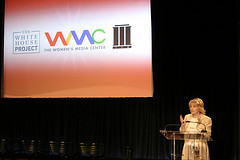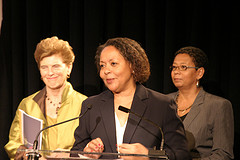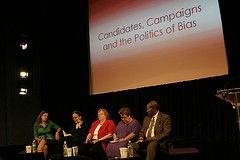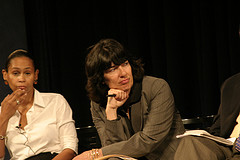
The Paley Center for Media in New York City was the location for a three-hour forum entitled "From Soundbites to Solutions: Bias Punditry and the Press in 2008 Election." Pat Mitchell, President and CEO of the institution that was formerly known as the Museum of Television and Radio, welcomed an audience of over 200 people to what she labeled as a "most important forum." Mitchell cited that the largest public archive of media was on the premises, and sardonically noted, "We don't have an archive of sexist soundbites from this year's election, but maybe we should."

The moving forces behind the forum were The White House Project, The Women's Media Center, and The Maynard Institute for Journalism Education. The president of each organization gave a brief summary of their respective missions. To start the ball rolling, Carol Jenkins (WMC) spoke about their campaign "Sexism Sells - But We're Not Buying It," which allows visitors to register their complaints about the coverage of women. Jenkins voiced how "pundits" had become embedded into the election conversation, and suggested that it was time to "sort out the sound bites and get to the solutions." She said that the WMC would be issuing a report with "action items."
Marie Wilson, who founded The White House Project to encourage more women to run for public office, related that that only 16% of Congress is comprised of women. Quoting Marian Wright Edelman, Wilson said, "You can't be what you can't see." The White House Project is a partner with SheSource, a database of women experts on a range of subjects, which was created to fill the paucity of women and women of color on the Sunday talk shows.
Dori Maynard spoke about how The Maynard Institute has been working for three decades to facilitate diversity in content and staffing for the national news media. She remarked that in this election cycle "race and class were pitted against each other," and expressed a hope that the gathering would be "a step forward" in reaching new goals.
With an eye to data, what looked like smart phones were given to each attendee for instant polling questions. The thought was to use audience participation as a jumping off point for discussion. An overview of the crowd showed that for Race and Ethnicity the makeup was 76% Caucasian; 11% African American; 3% Hispanic; 3% Asian; 3% Middle Eastern; and 4% Other. Age brackets divided up as 14% at 18 - 24; 14% at 25 - 34; 10% at 35 - 44; 20% at 45 - 54; 31% at 55 - 64; and 11% were 65 plus. Household income broke down as 7% earning less than $29,999; 20% at $30,000 - $59.999; 22% at $60,000 -$99.999; and 51% over $100,000 ("Introduce yourself to your neighbor," someone quipped.). The gender lines were 91% female and 8% male, with 1% other.
Callie Crossley, Program Manager at the Nieman Foundation for Journalism at Harvard, took the microphone to moderate the first panel, "Candidates, Campaigns and the Politics of Bias." The five speakers were given three minutes to make a statement about their rundown of the landscape. Crossley pointed to the "use of the narrative" invoking the Native American adage, "He who tells the story rules the world."

Pollster and political strategist for Democrats and progressives, Celinda Lake, gave insight based on facts. "We saw generation trumping gender," she said. "Obama never won women over 60 or lost women under 30." Class was a major divide, and voters felt the media had been hardest on age.
Dr. Susan J. Carroll, author and professor of political science, stated that the media didn't inform the public about the reasons behind Hillary's campaign strategy, which she felt was founded on the premise of deflecting gender bias and stereotypes. She posited that Clinton's concern about not being "too soft or too pacifist" led her to vote for the war in Iraq. "She couldn't afford to look weak," Carroll said, although murmurs in the crowd pointed to a difference in interpretation. She also suggested that in Clinton's desire to stress her abilities, she made experience her central point thereby "ceding the image of change." Carroll took the media to task for missing an opportunity to address the subtext of Clinton's choices.
Dr. Ronald Walters, Director of the African American Leadership Institute, saw race as a definitive fault line in the Democratic primary. He pointed out that Obama's campaign rose "from the middle of the road" and when originally behind with with black communities, there was the question of "was he black enough?" Through surrogates such as BET founder Bob Johnson, the Clinton campaign tried to "blacken him." On this tactic Walters observed, "I don't think this was an accident." He analyzed the efforts to "modify" the impact of of the Rev. Wright controversy against the continuous loop of replayed footage. He wrapped up with the thought that because of the Obama campaign strategy, the "black agenda was missing."
Perfect Girls, Starving Daughters author Courtney E. Martin, who writes for
The American Prospect on youth culture and politics, spoke specifically to the point of view of the younger generation. "I was born on the last hour, of the last day, of the last year of the 70's," she said. Martin explained that, "Younger voters want to see honesty, uplift, and justice." She saw less party affiliation among the demographic saying, "Chalk it up to Facebook." A key phrase for Martin was "identifying as individuals," which accounted for her statement "Being a feminist doesn't also translate to being a Hillary voter."
Patricia J. Williams, author, Columbia University law professor, and columnist for The Nation offered, "Race was gendered and gender was raced." She illuminated how Obama differentiated himself from the Clinton camp as he "spoke a slightly different language" that reflected "cosmopolitanism and globalism." She defined Obama as "post-race" adding that in our attempt to categorize Obama "we invisibilize the diversity of Americans." She questioned why there was a catering "to a narrative that women will never get to the White House." Williams reflected, "I would have loved to have seen in Hillary's conceding, 'I also throw my support to Michelle Obama.' " She ended with, "Imagine all the ways we can become women...and Americans."
When it was opened up to a group discussion, there was agreement that a lack of consciousness about gender stereotypes was pervasive, which led to the question, "If you don't recognize it, how do you address it?" Lake believed that it must be "named and pointed out systemically," adding that reporters "pay no price for being sexist." Carroll suggested the option of utilizing the "expertise in academia." When Crossley asked the group, "How do you transcend the question of otherness?" Martin replied that in this election she believed "otherness was an asset, as people were looking for extreme symbols of change."
There was a palpable frustration vocalized by moderator Crossley in the statement, "It feels like it doesn't go anywhere." There were mentions of "coded language" and whether women have "failed as a gender." On an upbeat note, Martin talked about how the "dissension between second and third wave feminism" had given rise to the younger generation becoming empowered to speak for themselves. Younger women identifying as feminists, but not as Clinton supporters, were decisive in the realization, "We're going to have our own voice too." Feedback from the audience included a comment by Jennifer Pozner, Director of Women In Media and News (WIMN), who had just returned from the 2008 National Conference for Media Reform in Minnesota. She brought up the topic of "intersectionality, and a media that doesn't cover that issue."
A short break allowed for some private talk. I was sitting next to Susan Davis, the producer of Invisible Women, which examines the fate of women in film over the age of 40. Discussing the students that learn about her movie as part of the curriculum at the University of Southern California she said, "It's that generation that's going to save us!"
The second panel, moderated by Geneva Overholser, Director of the School of Journalism at the USC Annenberg School for Communication, examined "How the Media Influence and Reflect
Political Realities." William Douglas, White House Correspondent for McClatchy, drew a difference between online and print media. He said, "Speaking for the print world, we've done okay. We've looked at race and gender differently, because we had to." He characterized some of the content on the web saying, "The Internet can become a bathroom wall."
New York Daily News columnist and co-host of Democracy Now, Juan Gonzalez, was blunt in his appraisal of the coverage. He said, "I've been extremely disappointed by the shallowness." He questioned how "Latinos were covered" and queried why there was "no attempt by the media to understand why Latinos gravitated to the Hillary Clinton campaign." Gonzalez also raised the subject of the "United States as a political empire."
Dr. Kathleen Hall Jamieson, Director at the Annenberg Public Policy Center, emphasized that, "We need to worry about an environment that may have reinforced rather than reexamined sexism." She quoted the asides of a cable commentator, "A charming speech with no stridency in it. She must have had a new speech writer." Jamieson also informed the audience that the combined search words "Hillary & Bitch" on YouTube brought up over 500 references (I found 738).
In concert with aghast listeners, Christiane Amanpour exclaimed, "I am almost hyperventilating listening to this." Reflecting on the fact that there are more women in parliaments in foreign countries, she said, "Thatcher never had these issues. The difference is quite large." 
Pointing to female leadership in Israel, Pakistan, and Rwanda -- where half the cabinet is women, she said, "People out there are making massive strides with less bitterness." Amanpour also lamented the lack of accountability and standards in the American media, holding up the rules and industry regulations of the BBC as a contrast.
Characterizing the Internet as "a free for all," Pamela Newkirk, Associate Professor of Journalism at NYU, believes there is still a long way to go. Mentioning Bill O'Reilly's remark about "a lynching party for Michelle Obama," she urged the participation of the public to voice their opinions. While suggesting "not to get into a them against us" mentality, she did acknowledge that "mainstream media is still controlled by white men." The next-step question that Newkirk raised was, "How can we have a discussion like this in newsrooms?"
Douglas suggested, "Different people from different backgrounds working together are hesitant to discuss certain issues," adding, "If you don't know it, just ask it." Newkirk said that there was a revolving door for journalists of color, who were always fighting to "point out something that is wrong." Gonzalez, with some incredulity asked, "We have so much media in this country, how can we be so misinformed?"
With the system "destabilized" by technology and the Internet challenging how we get information, how do you bring attention to coded language on gender, race, and age? How do you underscore that a woman candidate is portrayed as "giggling or cackling" when her male counterpoint just laughs? The audience was polled on the question, "In the coverage of the election to-date, do you think it is more accurate to say that the media have reported on bias, or created bias?" The response was: 7% reported on bias; 81% created bias; 12% not sure. Amanpour said, "I think it has reflected the bias."
Competition for ratings, news as "Infotainment," and the media's responsibility to educate as well as inform, were all raised as concerns. In the end, joint responsibility shared by the media, the campaigns, the government (FCC), and the public was deemed essential toward creating a more balanced situation.
On the way out, I picked up a "Quick Stats Sheet" about diversity in the media (Data courtesy of the American Society of Newspaper Editors). For broadcasting in 2003, local news directors were comprised of 6.6% minority and 26.5% women. In 2007, it was 10.9% minority and 26.3% women. For the newspaper industry, in the category of reporters in 2003 there were 13.6% minority and 39.5% women. In 2008, the numbers were 14.6 for minorities and
39.1% for women.
Clearly, there is a lot of work that needs to be done. Hopefully, this panel is just the beginning.
Photos courtesy of Trevor Little/The White House Project